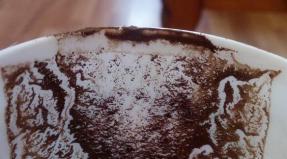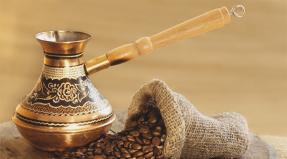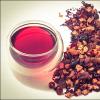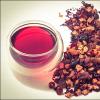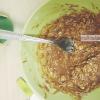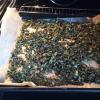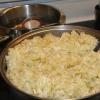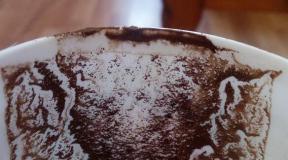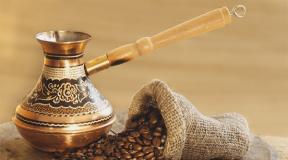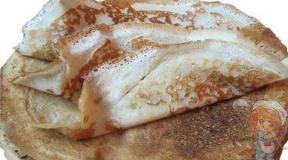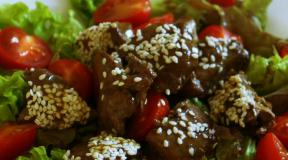How long to dry Ivan tea in the oven. Collection and procurement process
From time immemorial, Ivan tea has been known as a healing drink that was used to treat our ancestors. With urbanization and the development of the food and pharmaceutical industries, people began to forget about it, but recently there has been a trend of “returning to roots”, and more and more people are interested in collecting and preparing fireweed tea on their own.
It is worth noting that fireweed is a much more whimsical herb than any other plants that we are used to adding to teas and decoctions. You can’t just take it, grind it, dry it, and then pour boiling water over it and drink it.
The fact is that real tasty and healthy tea can only be obtained if it is properly fermented, dried and stored in proper conditions. If you follow a few simple rules, the result will be a truly healthy and healing drink, given to people by nature itself.
What to do with fireweed tea before drying
- collect fireweed leaves around June-July, during the flowering period, avoid diseased plants;
- rinse them thoroughly and let dry in a warm place;
- twist the leaves of fireweed into flagella, so that the juice is released, and leave to ferment for 8-20 hours, but in no case overdo it, no more than a day, otherwise the tea will not work;
- The leaves are now ready for drying.
How to dry fireweed
Typically, it is recommended to dry fireweed leaves in the oven, scattering them evenly on a baking sheet. It was this kind of drying that was applied to the original Russian recipe, which was passed down from generation to generation for many years. And although in those days a stove was used for this, modern ovens cope with the task no worse.
If for some reason it is not possible to dry the tea leaves in the oven, you can use an electric dryer, or warm them thoroughly in a thick-walled frying pan.
However, this article will consider the classic option of drying fireweed, that is, in the oven.
Step-by-step instructions for drying tea

- Fireweed leaves, pre-washed and fermented, need to be finely chopped or minced. It is worth noting that chopped leaves produce loose leaf tea, and those that have been microwaved produce granulated tea.
- The resulting herbal mass is spread on a fine sieve or on a baking sheet covered with dry parchment.
- The thickness of the tea layer should be approximately 1-1.5 centimeters. A layer that is too thick will be difficult to dry properly. If you pour a layer that is too thin, there is a chance that you will burn the leaves and end up with scorched, tasteless tea, devoid of all the beneficial properties.
- Do not dry tea in an overheated oven. The optimal temperature is 100 degrees Celsius, most often this is the minimum setting of the oven heater. If it is not possible to set a fixed temperature, you must use a thermometer and constantly maintain the temperature at the desired level so as not to spoil the tea.
- It takes about an hour to dry. However, the option of putting it in the oven and forgetting will not work in any case. It is necessary to remove the tray from time to time and check for readiness, at the same time stirring lightly and thereby ensuring uniform drying.
- Ready-made Ivan tea looks no different from regular black tea. Its tea leaves should break when squeezed in your hand. If this does not happen, the tea needs to be dried further, as it is not yet ready. However, the tea leaves should also not crumble into dust, since this means that the leaves were overexposed in the oven, and the drink made from them will not taste like the best black tea from a public catering establishment. Of course, it will retain virtually no beneficial properties, and all efforts will go down the drain.
- When the bulk of the tea leaves reaches the required consistency, you need to continue drying for some time at a lower temperature. Moreover, it is advisable to turn on draft (convection), if such a function is provided in the oven. During the main drying, draft is also allowed for faster and more thorough drying, but it should not be turned on too much.
- It is very important to continue to check the condition of the tea throughout the drying process. Over time, knowing the features of the oven, you can get the hang of it without any problems, knowing how long it will take and what the temperature should be at the beginning and at the end. But for the first time, it’s better to play it safe and check the consistency of the tea more often.
- The finished Ivan tea should be allowed to cool and only then put into jars. Tin containers that do not allow sunlight to pass through are best suited for this purpose. Many people prefer glass jars, which always show how much tea is left, but this way the drink quickly loses its beneficial properties.
What happens if you dry fireweed incorrectly?

- If you dry fireweed leaves like ordinary herbs without any preliminary preparation and fermentation.
The result will be a tasteless drink that tastes like hay brewed with boiling water..
People who made this mistake say that this tea does not have a drop of that magical aroma that real Ivan tea has. The beneficial properties of such a drink also remain a big question.
- If you don't dry fireweed leaves long enough.
Firstly, it will bear little resemblance to regular tea, something between black tea and herbal infusion. Secondly, it will still be healthy, but not as tasty and aromatic. Considering how many people drink fireweed not for its healing properties, but for its unique taste, the result will be very disappointing. In addition, if the fireweed leaves are not completely dried, then during storage the tea will quickly become moldy and become unsuitable for consumption.Therefore, if after drying in the oven the leaves still do not break when touched and look little like ordinary tea, you should dry them for a few more minutes until they can no longer be distinguished from ordinary loose tea.
- If you dry fireweed leaves for too long.
The first sign of this is that when touched, the tea leaves immediately crumble into dust. Unfortunately, it is no longer possible to correct the situation. Yes, you can still brew it as a tea and drink it, but the drink will taste like burnt paper, burnt, or resemble cheap black tea, which is completely tasteless and unpleasant.
Therefore, it is extremely important to monitor the quality of tea during the drying process and not allow it to be exposed to high temperatures for too long.
Secrets of successful drying of fireweed tea
- If the oven in which the tea will be dried is small, electric, or does not have the ability to set a low heating temperature, then:
- you need to sprinkle the leaves in a slightly thicker layer;
- Cover the top with parchment paper or a piece of clean natural fabric. This will prevent the tea from burning out too quickly.
- It is better to dry tea with the door slightly open to maintain the flow of fresh air, and also to avoid too high temperatures, which destroy the active trace elements in the leaves.
- If the oven allows, you can choose a lower temperature and dry at 50-60 degrees for up to two hours in a row. This is a more gentle mode, and with this option there is less chance of burning the leaves into embers.
- If you need to dry not only the leaves, but also the flowers, then it is better not to do this at the same time. Flowers have a more delicate structure, dry faster, and if you place them in the oven with leaves, they will burn quickly. Therefore, it is better to dry them separately and at a lower temperature.
- After the finished tea is taken out of the oven, you need to let it dry. Otherwise, it still retains a small amount of residual moisture. The old fashioned way is to do this in a clean old pillowcase somewhere in the breeze in the shade. If desired, you can sew a special bag. If the weather outside is damp and rainy, the tea will only get more wet, so in such a situation it is left in the room, if possible, in a cool and well-ventilated area.
The finished tea can be brewed either in its pure form or in combination with any other herbs - mint, lemon balm, linden flowers, any dried berries to taste.
Nature generously endowed man with food and drink. She also provided various remedies for diseases. They are respected and loved by people, each of them is capable of helping in a variety of situations. Our conversation will be about a unique plant and its properties: fireweed, how to collect and dry it and make tea from it.
Ivan-tea, scientifically, narrow-leaved fireweed, is a perennial characterized by long-term flowering, from early summer to mid-autumn, reaching 2 meters in height. Its rhizome is thick, new buds are regularly formed on it, and therefore it is not difficult to propagate. Long flower clusters with small pink-purple flowers are formed on tall peduncles.
Several types of fireweed are known - narrow-leaved, broad-leaved, Caucasian, others, more decorative, but no less healing. They differ in the size of the inflorescences and leaves, and the color of the flowers.
Ivan tea grows almost throughout Russia, Ukraine, and Europe, avoiding only arid places. It loves moisture and sunlight, and therefore is most often found in clearings and forest edges. It is one of the first to populate burnt forests, living along roads and railways, forming continuous thickets.
Note! Ivan tea is not collected as a raw material along highways and railway tracks. No matter how attractive the pink thickets of the medicinal plant are, they are not suitable for use, because... contaminated with exhaust gases.
We prepare fireweed
To use it in the form of medicinal tea or targeted infusions, you must follow the rules for preparing the plant.
When to collect fireweed
The best time to collect fireweed is July-August, while the honey harvest is in progress. During this period, most of the raw materials for tea are prepared. For urgent needs, flowers, stems with leaves, and rhizomes can be collected from the end of June - when flowering begins. It is preferable to dig up healing rhizomes in the autumn, when they accumulate reserves of nutrients for the winter.
The collection of grass is completed when the flowers begin to fluff - the seeds with fluffy parachutes ripen. During this period, there are very few useful substances in the green mass of the plant; the stems and leaves become rigid.

How to collect
The collection of green parts and inflorescences of fireweed is carried out according to the rules:
- The best homemade tea is obtained from raw materials collected in shaded areas - the leaves are easier to ferment.
- If there is no need to prepare medicines, only the leaves are torn off from the middle parts of the stems, starting from the peduncle. The lower ones are left because the plant needs them to maintain metabolic processes.
- Flowers and leaves are placed in separate bags.
- Do not take plants with signs of disease (presence of spots, darkening), damaged by insects.
- Unblown inflorescences are not cut off.
- The apical parts of shoots without peduncles also cannot be harvested; they are not suitable for tea.
Know! Unopened inflorescences and buds ripen when dried and begin to fluff, as a result of which the tea loses its beneficial qualities.
After collection, fireweed is sorted, but not washed, and leaves or flowers unsuitable for drying are discarded. The leaves are torn off the stems, because the latter are suitable only for preparing medicinal infusions.

How to dry fireweed correctly
Flowers for tea are dried like ordinary herbs - laid out on paper in a dry, ventilated room, protected from direct sunlight. The finished flowers acquire a thick, raspberry-lilac color. They are brewed separately, added to regular tea, or mixed with ready-made dry fireweed tea.
To prepare an aromatic drink, also called Koporye or Russian tea, fireweed leaves must be dried according to certain rules. The process includes 4 stages: withering, rolling, fermentation, drying.
Withering of leaves
After the collected leaves have been sorted, they are dried. To do this, the entire mass is laid out on a sheet of paper and left for 24 hours.
Note! The thickness of the layer of leaves should not exceed 5 cm, otherwise they will rot.
For withering, choose a cool, shaded room. Sun rays or elevated temperatures will dry out the leaves prematurely. The whole mass is stirred periodically so that the leaves dry evenly. The sufficiency of wilting is checked by folding one leaf in half. If the central vein has folded with a slight crunch, the raw material is ready for further processing. In rainy or cloudy weather, the process can last more than a day.
Rolling leaves
The procedure required to begin the fermentation process. Outwardly, everything looks very simple: the leaves are rubbed between the palms, twisting them into a tube. Continue until the leaves become wet and release juice.
When processing a large amount of raw materials, one pair of hands will not be enough; if there are no assistants, they resort to mechanical twisting, as described below.

Fermentation process
By fermentation of fireweed we mean the fermentation of the juice that came out of the leaves during twisting. Moreover, the whole process takes place with the participation of bacteria and microorganisms that live on the leaves in the natural environment. As a result, the biochemical composition of the raw material changes, and beneficial substances are transferred into an accessible form.
The twisted leaves are placed in dishes made of materials that are not subject to oxidation - glass, ceramics, food plastic. You can use enamel cookware if there are no chips or cracks on the inner surface.
Then the laid mass is pressed under pressure for 1-2 hours so that more juice is formed. Then the oppression is removed, the container is covered with a cloth (cotton or linen). The fermentation process has begun.
Interesting! In the old days, fluffy fireweed seeds were used to stuff pillows and mattresses.
Fermentation – degrees and tastes that are not in dispute
From the duration of fermentation, i.e. its degree depends on the taste of the resulting tea. There are three degrees and characteristic tastes for each:
- light, process duration is 3-6 hours. The tea is colored with a delicate bright floral and fruity aroma, the taste of the drink is soft. The color is similar to green tea;
- medium - 10-16 hours. The drink will have a pronounced aroma, tart taste with a slight sourness;
- deep - 20-36 hours. The tea will be tart, less aromatic, the color will be like that of strongly brewed black tea.
On a note! Experts advise not to hold the raw materials during deep fermentation so that the fermentation process does not end with the appearance of mold.

Drying
Completion of the process is drying. Leaves are dried in different ways, using an oven, electric dryer, or without technical means.
Drying without oven
Fermented raw materials are laid out on a baking sheet covered with parchment paper. The process takes place when heated to 60°C. A higher temperature will destroy the beneficial substances contained in the leaves; at a lower temperature the process will be delayed. The oven should remain slightly open to allow air to circulate.
Advice! Typically, the temperature scale of a gas oven does not have sufficient accuracy in reading temperatures below 100 °C.
To avoid overheating the raw materials, turn on minimal heating. The door is left ajar on the long side of the matchbox. This distance ensures uniform heating of the raw materials at a level of 55-60°, if the baking sheet is located at the middle height. Drying lasts about 1 hour, the condition of the mass is monitored. Readiness is determined by the following signs: leaves break easily; raw materials do not stick to your hands.
When the tea is ready, turn off the oven, open the door completely, and leave the baking sheet in place until the leaves have cooled completely. The raw materials are dried in an electric dryer at a temperature of 50-60°C, and the leaves are mixed twice during drying.
Tea dried under natural conditions retains more beneficial substances, although the process itself lasts about a week.
Fermented leaves are laid out on paper. The drying room must be dry and regularly ventilated. The place where the tea is dried should be light enough, but without direct sunlight. Dry the leaves and stir them 2-3 times a day.
How to make fireweed tea through a meat grinder
Previously, the whole family used to collect and dry fireweed for future use - they collected it together, processed it together. Today, “family contracting” is a rare thing; one person processes raw materials. Harvesting a large amount of fireweed without a minimum of equipment, just by hand alone, is impossible. The process is simplified by using a regular meat grinder.

Algorithm for preparing fireweed tea through a meat grinder:
- The prepared raw materials are dried.
- The dried mass is passed through a meat grinder. The output is small lumps of mass, similar to granules.
- Place in a suitable container, press lightly with your hands, cover with a cloth, and leave.
- Fermentation is stopped when the desired degree is reached - the mass is sent to dry in the oven. The degree of readiness of tea is determined by the condition of the granules. The product is considered ready if the granule crumbles when slightly squeezed.
Storing Koporye tea
Properly prepared Koporye tea can be stored from 1 (if it was made through a meat grinder) to 2-3 years. Storage conditions: dry room; a cabinet with solid (not glass) doors; a glass or ceramic jar with a tight-fitting lid.
Important! When stored in metal containers, fireweed tea loses its beneficial qualities.
Russian scientists believe that Russian tea can be stored longer - tens of years, if the air humidity does not exceed 70% and the temperature is kept within 15-20°. It is better to pack it in linen bags or paper bags.
Interesting! The finished tea should be allowed to rest for a month so that its taste and aroma develop more fully. It is even believed that with each year of storage, tea only becomes tastier and healthier.

The benefits and harms of fireweed tea
Koporye tea was drunk in Rus' long before the advent of traditional tea, brewed from the leaves of tea bushes. They not only quenched thirst, but were used as a medicinal drink for various health problems. The versatility of the use of fireweed is due to its chemical composition: microelements - copper, nickel, boron, iron, titanium; tannins; flavonoids; carotenoids; triterpinoids; vitamins; pectins; essential oils.
On a note! Ivan tea is 6.5 times richer in vitamin C than lemon.
Beneficial effects of Koporye tea:
- Improves blood composition, normalizes hemoglobin levels, stabilizes blood pressure.
- Accelerates metabolism, normalizes the functioning of the gastrointestinal tract, especially with ulcers and gastritis. Has a slight laxative effect.
- It has antiseptic properties and is useful for various inflammatory processes in the body.
- It has a positive effect on the prostate (some ancient sources call fireweed a male herb).
- It has a mild diuretic effect, normalizes the electrolytic balance of the body, it is recommended to drink it for urolithiasis.
- Helps in the treatment of respiratory diseases, gum problems, incl. during teething in babies.
- It has a mild sedative effect, relieves anxiety, relieves migraine headaches, normalizes sleep, helps with chronic fatigue and epilepsy.
- Promotes the removal of toxins and waste.
- Increases immunity.
- It has a beneficial effect on the functioning of the endocrine system, and is useful for cycle disorders and during menopause.
- Helps maintain skin elasticity and helps solve some skin problems.
- Characterized by a refreshing and tonic effect.
- Useful for weight loss diets, because... reduces cravings for sweets, reduces appetite.
Recent studies have shown that the leaves of fireweed angustifolia 9 fireweed contain substances that inhibit the appearance and development of tumors.

Doctors do not prohibit pregnant women from drinking Russian tea, as it is rich in nutrients and vitamins. It is useful for nursing mothers: it improves the composition of milk, increases lactation, and has a mild soothing effect.
Important! Consultation with an obstetrician-gynecologist and pediatrician is required!
When not to drink Ivan tea
There are few restrictions, the main ones are: gastritis with high acidity; increased blood clotting, thrombosis; with individual intolerance. Ivan tea is not recommended for children under 6 years of age. Also, when taking medications prescribed by a doctor, tea should be avoided so as not to enhance or weaken the effect of the medications.
Koporye tea lowers or increases blood pressure
Ivan tea does not contain caffeine, which increases blood pressure, so hypertensive patients can safely enjoy its taste and aroma. It is also useful for hypotensive patients, since it does not contain substances that can lower blood pressure. They only follow the dosage: people with high blood pressure brew tea according to the standard recipe; with low blood pressure, the concentration of the drink should be halved.
How to brew fireweed tea
The procedure for brewing Koporye tea differs little from regular tea:
- The teapot is rinsed with boiling water and 2-3 tsp is added. dried fireweed for a half-liter teapot;
- Fill the kettle with boiling water to about a third, let it brew for 5 minutes without covering it;
- add boiling water and leave for 10 minutes;
- Fireweed loses its healing properties after brewing 3 times.
On a note! Ivan tea can be brewed for future use - it retains its quality in the refrigerator for 5 days.
Koporye tea is prepared in combination with other herbs or berries. Sometimes they are added during fermentation, but more often they are added to taste directly during brewing. Some combinations mutually enhance the healing properties, for example, with thyme. This composition complements the action of fireweed: reduces swelling; eliminates flatulence; relieves hangover; treats persistent cough.
Those who want to independently prepare tea leaves for this healthy and tasty drink need to know how to collect and dry fireweed.
Properly prepared fireweed (fireweed, Koporye tea) has long been a worthy competitor to the best varieties of traditional tea. At the same time, it has a positive effect on human health. Its medicinal properties are many times superior to both black and green tea.
Basic information about the plant
Ivan tea (angustifolia fireweed) is a well-known medicinal plant. This perennial, whose height reaches 1-1.5 m, grows in almost all regions of Russia. It is found along roads, near bodies of water, in clearings, wastelands, and clearings.
Angustifolia fireweed blooms with red, pink, and purple flowers, collected in conical clusters.
All parts of the plant (flowers, leaves, roots) are used as medicinal raw materials. Fresh and dried fireweed is used to prepare tinctures, decoctions, and ointments.
Tea from this plant is a very effective remedy for the treatment of various diseases. It can be purchased at a pharmacy or prepared at home yourself.

Ivan tea is made by analogy with the production of regular tea. The main point in its preparation is the fermentation process, which can last 3-48 hours.
The duration and temperature of fermentation affects the smell, taste and color of the final product. Making this tea at home may result in a product with a green, yellowish or dark tint.
Ivan tea is a herb containing a lot of chemical elements such as iron, titanium, nickel, manganese, boron, copper, potassium, calcium, molybdenum, sodium, lithium.
In terms of its value, it surpasses such products as seaweed, citrus fruits, and black currants. This plant also contains B vitamins, which affect the metabolic process in the human body.

Fireweed does not contain caffeine, oxalic, uric and puric acid, which not only have a detrimental effect on metabolism, but can cause significant harm to health. It has excellent taste.
Ivan tea is a valuable product that not only improves overall tone and gives strength, but also helps eliminate headaches and migraines, improves the functioning of the nervous system, normalizes sleep, relieves stress and tension, and alleviates the symptoms of epileptic diseases.
Ivan tea is used in the treatment of neuroses, mental and post-traumatic disorders, gastrointestinal diseases (ulcers, gastritis, flatulence, enterocolitis).
It has a positive effect on the condition of the gastric mucosa, improves intestinal motility, normalizes metabolism, eliminates constipation, dysbacteriosis, heartburn, and has a choleretic and antiallergic effect.
Fireweed is an excellent prevention of oral diseases such as caries and periodontal disease.
It has anti-inflammatory properties, so it is used for the treatment of inflammatory processes of the respiratory system such as ARVI, tracheitis, tonsillitis, bronchitis, sinusitis, pharyngitis. Ivan tea normalizes temperature, eliminates chills and fever.
It is used in complex therapy of tuberculosis. This plant is useful for anemia, metabolic disorders, weakened immunity.
Ivan tea is an excellent antioxidant. It perfectly removes toxins, waste, radionuclides, and heavy metals from the body. Fireweed is effective for alcohol intoxication and delirium tremens. This plant has proven itself in the treatment of cancer.
Ivan tea increases hemoglobin levels, normalizes water and electrolyte balance, and reduces blood pressure. One of its most valuable properties is that it is not addictive.
As a tonic drink, Koporye tea perfectly quenches thirst and invigorates. It can be used during pregnancy and lactation as it has virtually no side effects.
It is used in complex therapy of infertility in men and women. As an external remedy, fireweed is used to wash purulent wounds and various skin diseases. Ivan tea is used as a cosmetic product, adding it to creams, masks, and steam baths.
When and how to collect fireweed
People who want to prepare a healing drink from fireweed angustifolia are wondering how to properly collect and dry fireweed.
In different regions of the country, this plant is harvested in June-August. At the same time, it must bloom. Fireweed leaves and flowers are collected separately. It is better to perform this procedure in the morning. The color must be cut carefully, choosing only the blossoming buds.
You should not collect brushes with unopened flowers, as during drying they can ripen and release fluff, which impairs the quality of medicinal raw materials.
The leaves are plucked from the stem carefully, moving your hand from top to bottom with a sharp but light movement. For the preparation of raw materials, only whole and undamaged leaves are used. They should not have dark spots or holes. The top and bottom leaves are not suitable for making quality tea.

Initial drying
Before fermentation of fireweed begins, the collected leaves are washed, laid out on cotton cloth and left in the shade for 12 hours. This is necessary so that the raw material becomes slightly dried, soft and unbreakable.
Well-withered leaves do not produce a crunch when folded in half. Raw materials ready for fermentation, when strongly compressed into a lump, should not open or crumble.

How to ferment fireweed at home
At the moment, several technologies for preparing medicinal raw materials from this plant have been patented. A very important point in this regard is the fermentation process (fermentation process) of the collected parts of the plant, which makes fireweed tea the most effective and gives it a refined aroma.
During fermentation, oxidation by air occurs, which promotes fermentation processes. To start the fermentation process, the collected leaves and flowers are crushed to release the juice. After this, the content of useful substances in the green mass increases.
When preparing raw materials, metal objects should not be used to prevent increased oxidation and deterioration of the taste of tea. The most popular methods for preparing Koporye tea are:
Easy way
In this method, the collected leaves are cut and placed in a pan or bowl. They are not cut too large so that they give the maximum amount of juice.
The prepared raw materials are kneaded well by hand and left at room temperature in a jar or other container for fermentation. It can last 24-36 hours.
It should be remembered that the higher the temperature in the room, the faster the fermentation process takes place. The raw material, ready for drying, has a pleasant fruity aroma.
Fermentation under pressure
Under pressure, in which the collected raw materials are divided into 2 parts. Juice is squeezed out of one of them using a juicer. The second part of the raw material is placed in an enamel pan and poured with the prepared juice.
A weight is placed on top (a wooden circle or a lid with a heavy load of 15-20 kg). In this case, the juice should not touch the load so as not to spoil the taste of the final product. The raw materials are left to ferment for 36-48 hours.
Old Russian method
With the Old Russian method, the leaves are scattered in a layer of 5 cm. The raw materials are left for 12 hours to dry. At the same time, it is periodically turned over, not allowing the top leaves to dry out.
The prepared raw materials are rolled with the palms of the hands into small sausages until the leaves darken. They are laid out on trays and covered with a damp cloth. Leave the raw materials in a warm place for 6-12 hours. The fermented leaves are finely chopped.

There are 3 degrees of fermentation of fireweed tea:
- light, in which the leaves are fermented for 3-6 hours. The final product has a mild taste and delicate aroma;
- medium, which lasts 10-16 hours. This tea will have a moderately tart taste with sourness;
- deep, in which the fermentation process lasts 20-48 hours. This tea will have a tart taste.

Photo: preparing raw materials for fermentation
Subsequent drying
After fermentation, the raw materials are roasted, during which the oxidation processes are stopped. The final quality of tea is greatly influenced by the time it is prepared.
So, the less time passes between the start of the fermentation process and drying, the less fermented it will be.
Depending on the technology used for preparing raw materials, Koporye tea can turn out to be green, red or long tea (black).
After the raw material changes color (darkens), it is dried in an oven or oven at a temperature of 100 ° C. To do this, the raw material is laid out on a baking sheet with parchment in a layer up to 2 cm thick.

If you don't have an oven, you can dry the leaves in a dry cast-iron frying pan. First, the raw materials are dried over low heat for about 40 minutes, and then the heat is increased to medium and the fireweed is brought to a dry state, stirring it constantly.
In general, the drying process of raw materials takes 1.5-2 hours. If during the drying process the temperature is below 60° C, you will get green fireweed tea.
The readiness of the tea is checked by touch. Well-dried tea resembles regular tea and has a rich and strong aroma. When squeezed, well-dried tea leaves break, but do not crumble into fine dust.
Drying inflorescences
Drying fireweed inflorescences is carried out similarly to drying leaves, but for a shorter time. If desired, you can mix dried flowers and leaves before brewing the drink to obtain a richer tea taste.

Storage rules
Dry fireweed tea is stored in a clean, dry jar, plastic containers or paper bags at room temperature.

To preserve its beneficial properties and taste, any container used must be tightly closed. This tea reaches commercial condition a month after storage.
Despite all the usefulness of fireweed, you should consult your doctor before using it, as in rare cases, some people have an individual intolerance to the components of this herb.
Also, you should not consume it in large quantities for a long time, as it can cause diarrhea.
Video: IVAN TEA: properties, collection, drying, fermentation
Now is the time to prepare Ivan tea, we have already made the second batch - now there is enough for the winter. This article contains a little information about such an important and necessary process for making tea as fermentation. What is it and why does tea not come out without it?
Properly prepared greens and inflorescences of Ivan tea for brewing allows you to obtain tea that is not inferior in taste and aroma to the best varieties of Ceylon and Indian tea. To be honest, it’s “a matter of taste and color,” as they say, but for a LONG time we have liked fireweed so much more (including how it affects human health) that we no longer consider regular teas a product that can be consumed. In terms of their healing properties, they cannot be compared with Ivan tea.
Surprisingly, we in Russia have stopped appreciating this “green gold”. Only recently have the traditions of producing and drinking Ivan tea begun to be revived, and much has to be learned anew and traditions restored.
In addition to taste, fireweed has a wide range of healing qualities and, unlike regular tea, does not contain caffeine or other harmful substances.
Currently, several methods, or rather technologies, for producing fireweed tea have been patented in Russia, the main secret of which is the technology of the fermentation process (fermentation process).Fermentation (fermentation)
Fermentation consists of roasting and air oxidation. Oxidation starts fermentation processes in the crumpled leaf, which gradually oozes juice. Cooking stops them. The less time passes between the start of fermentation processes and their stop, the less fermented the tea will be considered. 
Depending on manufacturing technology Ivan tea can be black (baikhovy), red and green. They taste quite different. In addition, varieties are produced with aromatic herbal additives; you can also cook with berries.
. It is advisable to use herbal infusions, decoctions and teas prepared in only from fermented raw materials
.
This applies to most medicinal and aromatic herbs. Raspberry, strawberry and currant tea can be made in a similar way. Makes delicious drinks. Now we are trying to prepare tea from currant leaves in this way. The fermented maple leaf tea turned out great!
Fireweed itself protects itself from destruction - it has an amazing ability to reproduce, so fortunately it will not be possible to destroy the population with reasonable harvesting. :-) The broken apical part of Ivan tea very quickly becomes overgrown with lateral flowering shoots, which manage to produce abundant seeds over the summer. And an intact plant produces an amazingly large number of seeds. Thus, fireweed inhabits a variety of places: wastelands, landfills, roadsides, fires, clearings, etc. The territories where unprecedented fires raged in the summer of 2010 will be reclaimed by fireweed. At our fire (an old building burned down), he appeared the year after the fire. Now there is his small plantation there.
It is better to take raspberry, currant, blackberry, and fireweed leaves in the first half of summer, when they are more fragrant. On the contrary, it is advisable to collect strawberry leaves in early autumn, when they accumulate the greatest amount of useful substances.
The plant itself already contains everything necessary for fermentation. These are his own juices and enzymes. If you crush a leaf in your hands, some of the cells will collapse and the plant will release juice. Moist, crushed leaves will contain vitamins, nutrients and intracellular enzymes. These enzymes, emerging from the vacuoles, begin to actively change the biochemical composition of the plant. This is self-digestion.
By the way, brewing Ivan tea does not stain tooth enamel.
Fermentation (chemical process) is a special chemical process caused by so-called enzymes. During the process of fermentation (there are many types of them!), a complex particle of organic matter breaks down into simpler ones, that is, containing a smaller number of atoms.
One way to prepare Koporye tea at home:
- The collected leaves and flowers should be dried a little. It is enough if they lie in the shade in the breeze for 2-8 hours, depending on the thickness of the leaves. It is necessary that the leaves lose some of their moisture, but do not dry out, but become soft and not brittle. You can collect leaves from the middle part of the fireweed stem (not just the top), tearing them off with one movement of your hand - quickly, and it does not harm the fireweed at all.
- Scroll the raw materials through a meat grinder (we do this exactly - not with our hands, otherwise it is very difficult to prepare fireweed for a large family for the whole year) and place the resulting mass in an enamel bowl and cover with a lid or plate of the appropriate diameter. Place the bowl in a warm place (25-30 °C) for about a day. At this time, an accelerated fermentation process of tea will occur, just like during fermentation.. Soon the mixture will darken and acquire a pleasant fruity-apple aroma. For us, when we cook a lot, we put the mass in a huge enamel pan - at night, in the morning - we already begin drying.
- There is another original way to ferment herbs. According to experienced herbalists, in this case the result will be even better. The stock of tea leaves for Berendey tea is prepared as follows: the dried leaves are placed in a cast iron pot (cast iron) and placed in a heated Russian oven for 10-12 hours. Can be done in an electric oven in a roasting pan or any ceramic dish. We keep the temperature around 60 degrees. Prepared leaves for Berendey tea should be stored in a tightly sealed container, like any tea in general. In this case, you can mix different leaves in advance or store them separately and mix them before brewing.
- After fermentation, place the leaf in a cast iron frying pan and simmer over very low heat for about forty minutes, or in the oven. Warming up to a hot state is necessary to accelerate fermentation, during which part of the insoluble, non-extractable substances of plant tissue are converted into soluble and easily digestible. These are the substances that give the taste, smell and color of tea.
- Then you can do it in different ways. For example, spread the mixture evenly onto a dry baking sheet and place in the oven, preheated to 90 °C. Dry, stirring occasionally, until completely dry. The output will be granulated dark brown tea. Can be dried in a dryer at 45, the tea will be lighter. You can dry it a little in a dryer (so that it doesn’t stick to the trays; after fermentation, the tea is very wet), and then put it in the oven; if you need black and very strong tea, you can put it at 150 degrees.
If you dry the fermented mass at a temperature of 60 ° C and below, you will get green tea... Not quite green, because... after fermentation, it still gives a deeper color, but close to green. 
It is not at all necessary to run the raw materials through a meat grinder. You can chop it finely and squeeze it with your hands to release the juice. You can rub it between your palms - into “sausages”.
It is best not to use metal when cooking. This will prevent oxidation of the raw material upon contact with metal and thus protect the vitamins and other useful substances contained in it from destruction. Hand-made tea is different from meat-grinder tea. But preparing it is more difficult; you can make some part like this.
Another suggested method: Grind the berries together with the herbs in a meat grinder: for example, for currant tea, we grind the leaves together with the berries (you can also use the branches with the berries on them), then we ferment the whole mass together and dry it. Haven't tried it yet, but the scent must be AMAZING! Or a little differently - first we ferment the leaves, and before drying we fill them with berry paste, mix and dry. Probably, these two cooking methods will give slightly different results, you need to try it.
When collecting Ivan tea, you should keep in mind that during the flowering process, seed “pods” appear at the top of the stem. During the initial flowering period, they, along with leaves and flowers, are used to make tea. Subsequently, seeds are formed in them and abundant fluff and pods become unsuitable for tea. It is necessary to check the suitability of the raw materials: break the pod and make sure that it is in a state of “milk ripeness”, i.e. does not contain fluff. In general, fluff is not a problem for tea, but it flies a lot when you open the jar. :-)
Drying tea
 Fireweed can be dried in conventional dryers, as well as in an electric oven, and, of course, in a Russian oven.
Fireweed can be dried in conventional dryers, as well as in an electric oven, and, of course, in a Russian oven.
The effect of fireweed on health
 Fireweed tea has an astringent, enveloping, emollient, anti-inflammatory, diaphoretic and diuretic effect. It is used for gastritis, colitis, intestinal disorders and other diseases of the gastrointestinal tract, as an antiepileptic and hypnotic. Ivan tea is used to treat anemia, ulcers, wounds, inflammation of the nose and throat, metabolic disorders and inflammation of the mucous membranes, diseases of the kidneys and liver, cardiovascular and genitourinary systems.
Fireweed tea has an astringent, enveloping, emollient, anti-inflammatory, diaphoretic and diuretic effect. It is used for gastritis, colitis, intestinal disorders and other diseases of the gastrointestinal tract, as an antiepileptic and hypnotic. Ivan tea is used to treat anemia, ulcers, wounds, inflammation of the nose and throat, metabolic disorders and inflammation of the mucous membranes, diseases of the kidneys and liver, cardiovascular and genitourinary systems.
Recently, the drug chanerol, which has a pronounced antitumor effect, was obtained from the inflorescences of Ivan tea.
For men, fireweed is useful for the prevention and treatment of prostatitis and prostate adenoma.
Properties of herbs and fermentation
Processing of herbs - fermentation (actually fermentation) is carried out to improve their properties.
Take, for example, a cherry leaf. Crumple it to make the juice appear, you need to break the intercellular membranes. Place in an enamel bowl, cover with a wet towel, keep in a warm place for 3 days, moistening the towel. The leaf should change color and become sticky. Place on a baking sheet and dry in the oven with the door ajar until the aroma of expensive tea appears. The sheet will become brittle and crumble in your hand. So treat each leaf (grass) separately. Then mix the herbs in equal proportions.
In Siberia, mixtures of 3, 9, 12 or 14 herbs are considered healing.
Plants prepared in this way acquire amazing and special properties that would not appear with simple drying.
A simplified method for preparing and fermenting herbs: crush the herbs, put them in a saucepan, cover with a lid and simmer over low heat for 30 minutes until the color changes. Then dry in a frying pan and grind through a colander. Brew the mixture in a teapot and drink instead of tea.
Silage and fermentation
To better understand the topic, it is also necessary to mention what silage is, which is prepared for livestock. It turns out that silage is also fermented grass. Very valuable information is a description of the processes that occur during fermentation.
British farmers harvest grasses while they are still in a relatively early stage of growth, high in fermentable sugars (WSC) and low in fibre. Whether the crop is harvested immediately or left on the field to wither for several hours depends on the weather conditions at the time of mowing, but ideally the farmer wants to silage a crop with a dry matter content of 25-30%. 
Usually the first phase of fermentation is short-lived. Initially, the trapped atmospheric oxygen in the raw material is used by plant enzymes in still breathing plants, but the oxygen soon runs out, and further fermentation occurs under anaerobic conditions. At this time, lactic acid bacteria, initially present in small numbers, begin to rapidly multiply to a concentration of 109 -1010 cells/g, using sugars released from destroyed plant cells as the main source of energy.
In in the second phase - main fermentation - lactic acid bacteria play the main role, continuing to acidify the feed. Most non-spore-bearing bacteria die, but bacillary forms in the form of spores can persist for a long time in fermented feed. At the beginning of the second phase of fermentation in the silo, it is usually cocci predominate, which are later replaced by rod-shaped lactic acid bacteria, characterized by high acid resistance. Under ideal conditions the pH stabilizes at 3.8 - 4.2, depending on the dry matter content, and the silage is effectively preserved within a few weeks. However, when the dry matter content of the grass clippings is less than 25%, conditions are not ideal and the preservation process may then not proceed well, especially if the level of ASU is also low (as is often the case with grasses grown in temperate climates).
To increase the crude protein content in the silage, as well as improve the fermentation of feed during the laying period, add molasses, urea, soybean meal. Finely chopping cobs and cob wrappers increases the palatability of silage by 30%.
Most leguminous plants are difficult to ensile, because they contain relatively little sugar (3...6%) and a lot of protein (20...40%). Leguminous grasses belong to the category of difficult-to-silage or non-silageable plants. Enzyme preparations not only silage the feed, but also enrich it with easily digestible nutrients. These are celloviridin, pectofoetidin, cellolignorin, glucomarin, etc. In the conditions of Uzbekistan, the enzyme preparation celloviridin was used for ensiling green alfalfa.
When analyzing the development of microbiological processes in silage prepared under natural conditions, it was found that during the spontaneous fermentation process (control silos), putrefactive bacteria grew very intensively, in particular in silage from alfalfa. As a result of the rapid development of ammonifiers in legume silage, the enrichment of lactic acid bacteria slowed down; and in corn silage it was very intense. In the control silage prepared from alfalfa waste, due to the slowdown of lactic fermentation, butyric acid bacteria (titer 103) were observed at the end of the experiment. Due to the strong growth of ammonifiers, the control legume silage had an unpleasant odor of protein decomposition during organoleptic testing. When using additives, the growth of putrefactive bacteria slowed down, which contributed to the preservation of carbohydrates necessary for lactic acid fermentation in the silage.
An excellent silage crop is corn; its stalks and cobs contain 8...10% protein and about 12% sugar. Sunflower ensiles well, as it contains a lot of protein (about 20%), but also enough carbohydrates (more than 20%).
Feeding cows whose milk is used for cheese with poor-quality silage that has undergone butyric acid fermentation causes similar fermentation in the cheese.
Yeast is also undesirable in silage. Typically, after initial rapid reproduction, aerobic species such as Candidas spp. and Pichia spp., remain dormant under anaerobic conditions until the silo is opened for animal feeding. Aerobic deterioration of silage at the surface of the pile can be very rapid and result in complete loss of nutritional value, accompanied by the formation of carbon dioxide, water and heat, as seen in the typical yeast reactions below. If anaerobic conditions are established quickly and the achievement of a low pH is delayed, then in addition to Clostridium species, yeast may also be a problem. Being tolerant of slightly acidic conditions, anaerobic yeasts such as Torulopsis spp. compete with lactic acid bacteria for sugars, which they convert into ethanol and carbon dioxide with a loss of DM and an increase in silage temperature.
Let's return to the main bacteria involved in silage - lactic acid bacteria. Among the lactic acid bacteria of silage there are cocci and non-spore-forming bacilli: Streptococcus lactis, S. thermophilus, Lactobacillus plantarum, and from the representatives of the second - L. brevis. These microbes are anaerobes. The nature of the products formed by lactic acid bacteria is affected not only by the biochemical characteristics of a particular culture, but also by the type of carbohydrates. Plant raw materials contain pentosans, which yield pentoses upon hydrolysis. Therefore, even with normal ripening of silage, a certain amount of acetic acid usually accumulates in it, which is also produced, as is known, by some other lactic acid bacteria from hexoses. Most lactic acid bacteria live at a temperature of 7...42 °C (optimum about 25...30 °C). When heated to 60...65 °C, lactic acid accumulates in it, which is produced by some thermotolerant bacteria, for example Bacillus subtilis.
The third phase of feed fermentation - the final one - is associated with the gradual death of pathogens of the lactic acid process in the ripening silage. By this time, silage comes to its natural end.
The quality of silage feed can be judged by the accumulations during fermentation.
The quality of natural silage fermentation is highly dependent on the number and type of lactic acid bacteria, present in the forage during silage laying. Of the four genera of lactic acid bacteria associated with silage (Lactobacillus, Pediococcus, Streptococcus, Leuconostoc), over time Lactobacillaceae begin to dominate the silage microflora.
In temperate climates where the sugar content of the forage may be low, the demand for lactic acid bacteria in the silage ASU may outstrip their supply, and a change in the fermentation pattern may occur towards the dominance of heterofermentative lactic acid bacteria.
High nitrate levels in silage can affect subsequent fermentation. The content of ASU in the grass negatively correlates with the level of nitrates used for plant nutrition due to the rapid growth of the grass stand. When the total nitrogen content in the samples exceeds 100 g/kg, it appears that lactic acid bacteria in silage are not able to lower the pH to a level sufficient to suppress the activity of clostridia due to the limited amount of substrate. The results show that secondary fermentation does not occur under such conditions. .
Ivan-tea, otherwise called narrow-leaved fireweed, is a perennial herbaceous plant found in Russia. The leaves are used to prepare a drink that contains many trace elements and nutrients; it is characterized by a beneficial effect on the human body.
A drink made from fireweed tea is an anti-inflammatory and antitumor agent. It helps reduce allergies, strengthen the immune system and increase tone in the body.
It is important that after drying the plant retains all its benefits. Therefore, it is necessary to know how tea is harvested.
Let's consider several questions: how to collect and dry fireweed. Fireweed can be found in dry sandy forest clearings and at the edge of the forest; it also grows near bodies of water. This grass is the first to begin to grow in areas of fire where all vegetation has been destroyed by fire. Fireweed is found near raspberry bushes.
Ivan tea is collected during its flowering period, which begins in June and ends in August. Tea from fireweed collected at different times will differ in taste.
Many people prefer a drink made from young leaves, which are collected at the end of May. When collecting leaves, flowers, and inflorescences, you always get no more than a third of the total mass of the resulting raw materials.
Collection is carried out manually. Hands lead along the shoot from top to bottom. This way the shoot will remain undamaged.
When collecting flowers, make sure that fruits and seeds do not get into the raw materials. If they are collected, the drink made from it will contain fluff from the fruit.
Withering
From the name of the process we understand that the leaves need to be allowed to “wither”. To do this, the raw materials are laid out on any durable surface in a five-centimeter layer and left for 24 hours. Moreover, the raw materials should be turned regularly so that they wither under the same conditions.
Do not leave the grass outside, place it at home in a place where there is no direct sunlight. Because of the sun and wind, the leaves will simply dry out, but we need them to wilt a little. Affected leaves, as well as snails and other debris should be removed. Washing the grass is strictly prohibited - all this must simply be removed.

After 24 hours, you need to take a piece of paper and fold it in half. If the vein in the center crunches, the raw material should be left for another day. A similar phenomenon is observed only in cloudy and rainy weather.
Twisting
If you are harvesting a large amount of fireweed, it is better to use a meat grinder to roll it. If it is not possible to use it, take the leaves and rub them between your palms until they curl into a “sausage” shape. The rolling procedure continues until a small amount of juice appears.
Fermentation
Before you start drying fireweed, it must be prepared. To obtain a real, high-quality and tasty drink in the future, it is subjected to a fermentation process. This is a very important procedure.
At the end of manual twisting or through a meat grinder, the raw materials are placed in plastic or ceramic dishes; you can use an enamel container. If the leaves are twisted in a meat grinder, you should press on them with your hand to lightly compress them, but if twisting was done by hand, the raw material should be covered with a lid and pressed down on top with a stone to create a kind of press for some time. The container is covered with a cloth and the raw materials are left to ferment. Let's get acquainted with fermentation methods, since they determine the taste and aroma of the future drink.

Fermentation differs according to the following characteristics:
- mild degree - 3-6 hours. A floral-fruity aroma begins to appear. The tea will be soft with a strong and delicate aroma;
- medium level – 10-16 hours. The drink will be slightly sour, tart, with a pronounced aroma;
- deep degree – 20-36 hours. The tea will be tart with a slight odor.
Important! It is better to slightly underferment the raw material, rather than it fermenting and starting to become moldy.
How to dry properly
To obtain tea that can be brewed throughout the year, you need to know how to dry fireweed at home. During the drying process, the raw material undergoes fermentation, which gives the future drink a certain taste and deep aroma.
Regular way
This fireweed method is the simplest and fastest:
- the collected raw materials are dried on a flat surface and mixed regularly;
- when the leaves become dark and curl into flagella, they are placed in a glass container and covered with a wet cloth, left in this form for 12 hours;
- then the fireweed is laid out on a baking sheet and sent to the oven to dry. Duration – 45 minutes, oven temperature should be 100 degrees.

Drying in the shade
This drying method will require more time and effort:
- fireweed leaves are collected and dried in the shade for 24 hours;
- dried leaves are twisted by hand in the form of flagella until a little juice is released;
- the resulting flagella are laid out on a baking sheet, covered with a dampened cloth and left for 7-8 hours;
- then the flagella unwind and are laid out again on the baking sheet;
- You need to dry it in an oven heated to 50-100 degrees, about 45 minutes with the door slightly open.
When dried at a lower temperature, the raw material will become lighter in color, and the tea from it will taste similar to green tea.

Recipe with freezing
Preparation with freezing is carried out as follows:
- the collected leaves are placed in cellophane bags and kept in the freezer for 7-8 hours;
- then the plant is defrosted, laid out on a flat surface, crushed with hands and covered with gauze;
- kept for several hours to complete fermentation;
- laid out on a baking sheet, sent to the oven, heated to 100 degrees, and dried for 2 hours with the door open, then the temperature is reduced to 50-60 degrees and dried until the moisture has completely evaporated.
Dried fireweed tea is stored in a glass jar. The qualities of the plant are preserved for several years, but more often the raw materials are used within 1-2 years.
